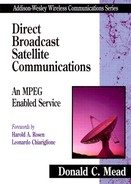Book Description
With its higher power and superior video and audio quality, Direct Broadcast Satellite (DBS) communications is proliferating worldwide. Many new DBS systems are evolving and with the introduction of HDTV, DBS technology is predicted to become even more prevalent.
Written by a leading DBS authority, this book is required reading for anyone involved in this burgeoning field. This comprehensive reference describes the history and structure of DBS systems, the regulatory environment, the subsystems that support it, and the underlying compression technology that makes it commercially feasible. Direct Broadcast Satellite Communications can be read as a broad overview of DBS systems or can serve as a detailed technical description.
In particular, the author thoroughly explains how MPEG compression standards are used to implement modern satellite broadcast systems. You will find complete information on key topics such as:
International and FCC regulations
Radio frequency components of DBS systems, including the shaped reflector antenna
Forward error correction, looking at block codes, interleaving, and Viterbi decoding
The use of cryptography for conditional access to subscription services
MPEG system and transport layer
MPEG-2 video and audio compression
Connecting terrestrial systems and DBS uplinks
The Integrated Receiver Decoder
In addition, the book explores future developments, including the Spaceway and the Global Broadcast Service, as well as the MPEG-4 compression standards. Numerous case studies involving DIRECTV(TM) and the European DVB standard appear throughout the book. For other books in this series, see http://www.awl.com/cseng/wirelessseries/
